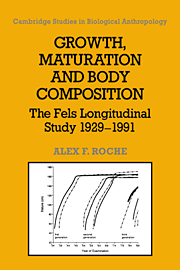Book contents
7 - Body composition and risk factors for cardiovascular disease
Published online by Cambridge University Press: 13 March 2010
Summary
‘It is not growing like a tree in bulk, doth make men better be.’
SamuelJohnson (17097–1784)Interest in body composition at Fels is reflected in the data collection protocol from the first years of the study. This early interest was related to the amounts of adipose tissue, muscle and bone at local sites. The possible practical application of this work was soon realized. Garn (1962c62) wrote: ‘Body composition attracts interest from clinical and preclinical disciplines,’ but later (1963a63) he noted that, despite the established relationship of total body fatness to the probability of death (longevity) and of the amount of bone mineral to osteoporosis, little had been done to associate variations in regional body composition with the risk of disease or the probability of death. Garn (1963a63) also claimed that an excess of muscle mass predisposed to coronary atherosclerosis but tended to protect against osteoporosis.
The Fels Longitudinal Study was transformed in 1976 by placing an increased emphasis on serial changes in total and regional body composition in relation to risk factors for cardiovascular disease. The initial plan for the body composition aspect of the study was complex and further complicated by the irregularity of federal funding. As an overview, data are now collected annually from participants aged from 8 to 18 years who live within 80 km (50 miles) of Yellow Springs and then at 3-year intervals until 40 years, after which the examinations are at 2-year intervals. The intervals between examinations are longer for those who live further from Yellow Springs.
- Type
- Chapter
- Information
- Growth, Maturation, and Body CompositionThe Fels Longitudinal Study 1929–1991, pp. 199 - 240Publisher: Cambridge University PressPrint publication year: 1992
- 2
- Cited by



